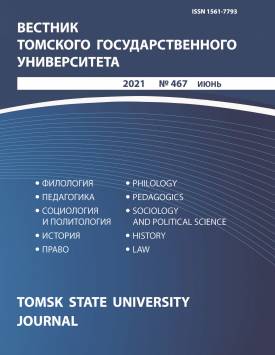Euphemistic Representations of the Act
The aim of this article is to investigate euphemisms underlying the act of adultery in English. The research objectives are to build a frame model of the act of adultery, to define the components of this model which emphasize different aspects of this situation, to analyze which components are represented by a larger number of euphemisms, and to figure out the most popular devices that are used in the creation of euphemisms of adultery. The sources of the material are English dictionaries of euphemisms, modern texts of the British National Corpus, Google, messages from the Twitter social networking service (in general about 5,000 texts with 127 lexemes that represent the situation of adultery). In the furtherance of the goals, the following methods are applied: the method of continuous sampling, the analysis of the semantics of the lexemes, contextual analysis, quantitative analysis, frame-based analysis. A frame is considered to be one of the means of structuring knowledge and experiences. By means of vocabulary research, euphemisms which are used to denote the situation of adultery are identified. These words are thoroughly analyzed in terms of their semantic peculiarities, their functioning in the modern English discourse, which helps to design a frame-model of the situation the lexemes represent and define its basic elements which are “agent of adultery”, “counter-agent of adultery”, “patient of adultery”, “action behind adultery”, “aim of adultery”, “valuation of adultery”, “location of adultery”. The quantitative analysis specifies the core of the frame and helps to find less significant elements within the frame. The most popular devices employed to disguise the act of adultery are determined. They are generalization, the use of terms, metonymy, understatement, metaphor. Terms of high generality, although having negative meaning, are used in order to blanket the sensitive topic of adultery and make it difficult to understand it out of context. The use of religious and law terms is a way to hide the immoral act behind an obscure word. Metonymy, defusing a strong statement about the act by emphasizing some of its elements, shifts attention from the negative side of the act. Understatement helps to make the situation of adultery seem less indecent than it really is. Metaphoric euphemisms that represent the situation of adultery are aimed at making a more positive impression when talking about adultery.
Keywords
act, adultery, frame, euphemism, stigma, generalization, metaphor, metonymyAuthors
| Name | Organization | |
| Bushuyeva Lyudmila A. | Lobachevsky State University of Nizhny Novgorod | sebeleva@yandex.ru |
References

Euphemistic Representations of the Act | Vestnik Tomskogo gosudarstvennogo universiteta – Tomsk State University Journal. 2021. № 467. DOI: 10.17223/15617793/467/1
